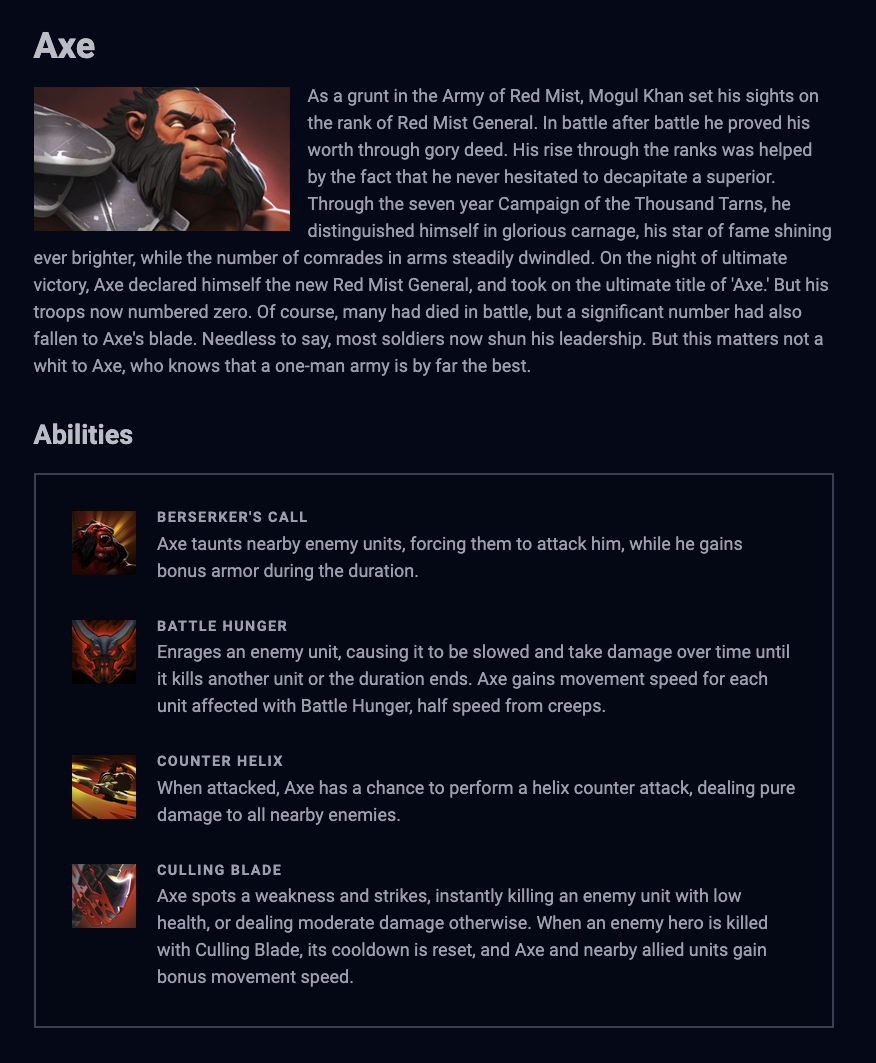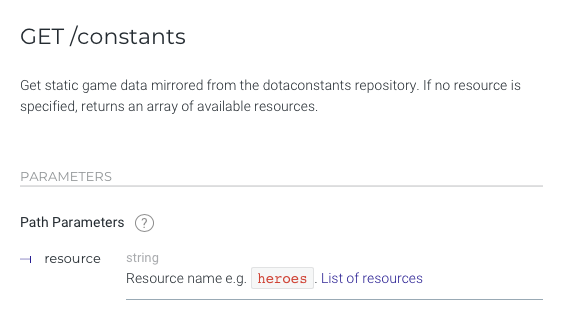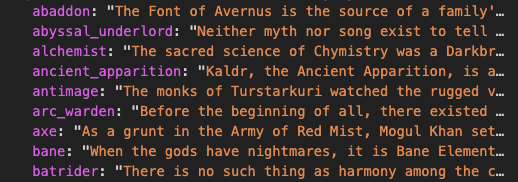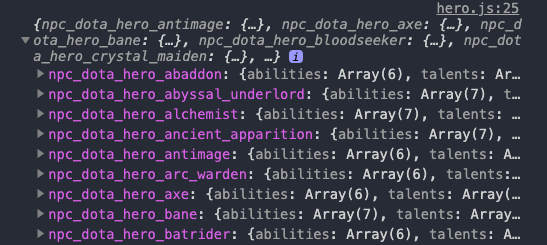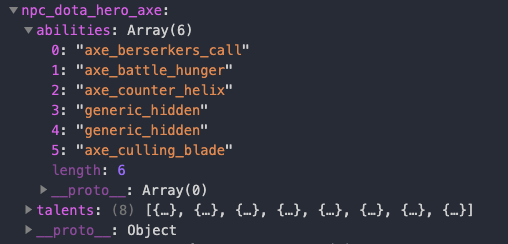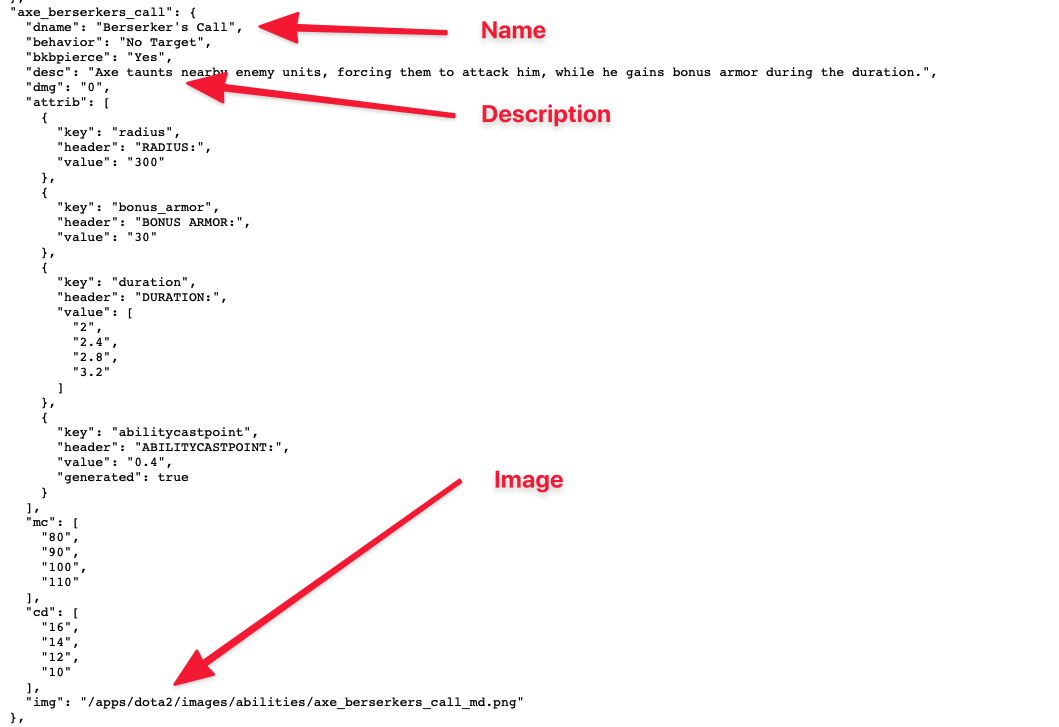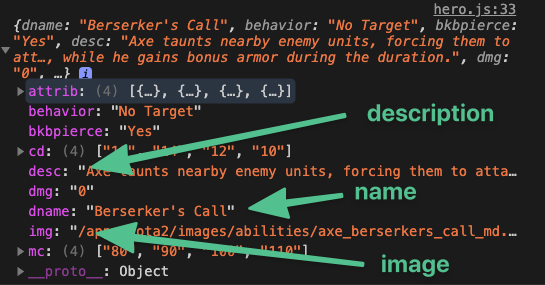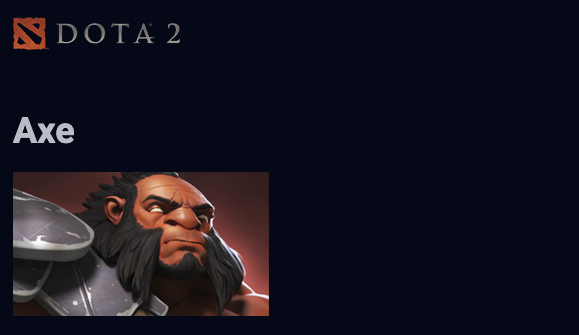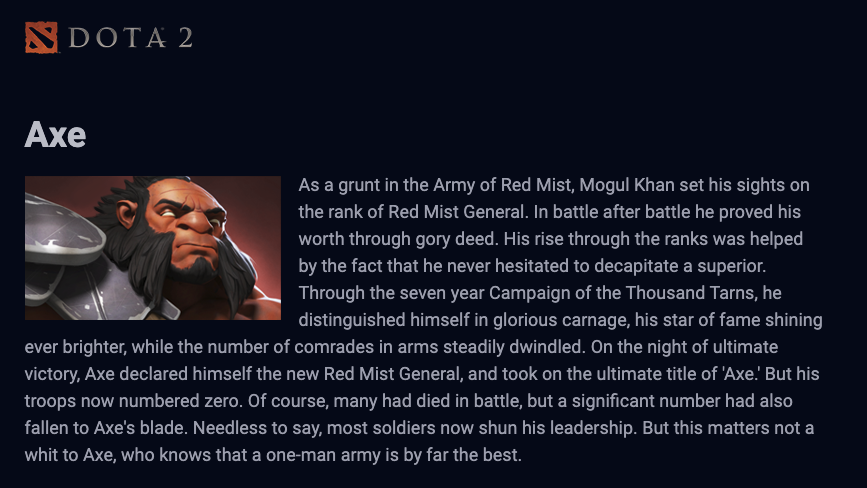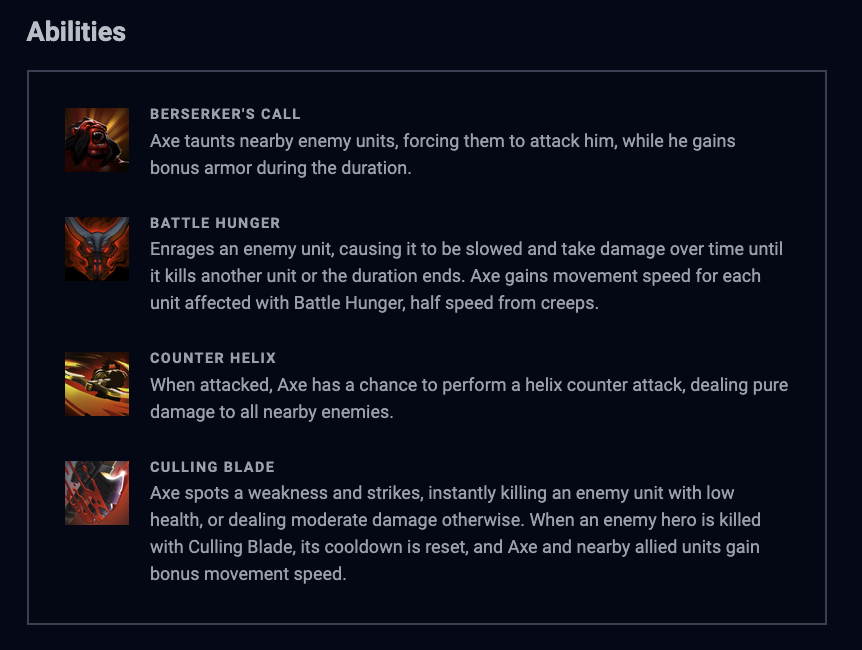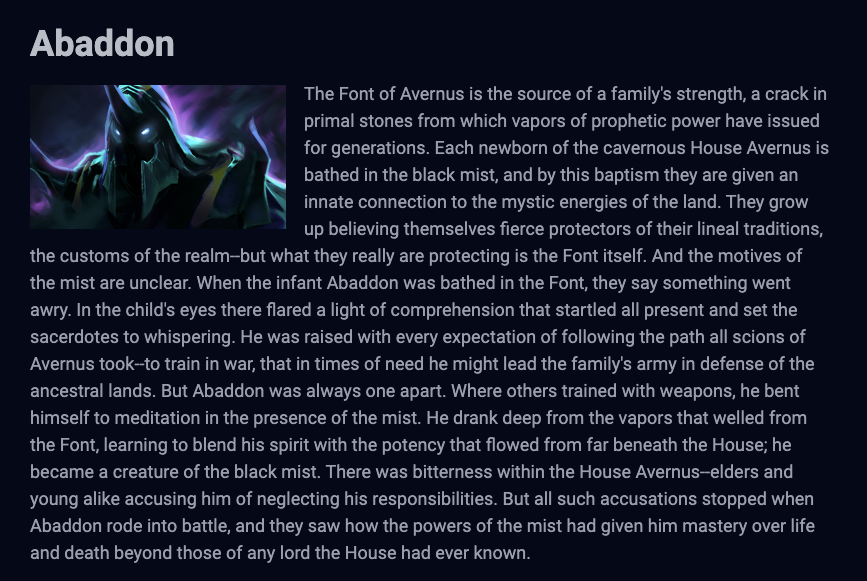🛠️ Dota Heroes: Hero Page
We will build the Hero Page for the Dota application. Here’s an example of what it looks like:
We’ll eventually combine this page with the Heroes List Page to make a full application. For now, let’s be patient and do one thing at a time.
Please use the Starter file given to you in this lesson. We’ll write the HTML in a file called hero.html and the JavaScript in a file called hero.js.
Please also navigate to /hero.html in your browser to view this page.
Anatomy of the Hero Page
The Hero Page contains 4 pieces of information:
The hero’s name
The hero’s image
The hero’s description
The hero’s abilities
For now, let’s say we want to fetch information about the hero Axe. We’ll set heroName to be axe.
const heroName = 'axe'
We can get the hero’s image via the heroes endpoint.
zlFetch(`${dotaApi}/constants/heroes`)
.then(response => {
const heroes = Object.values(response.body).map(hero => {
return {
name: hero.localized_name,
attackType: hero.attack_type.toLowerCase(),
primaryAttribute: hero.primary_attr,
roles: hero.roles.map(role => role.toLowerCase()),
image: `https://api.opendota.com${hero.img}`
}
})
})
.catch(console.log)
Getting the hero’s description and abilities are slightly tougher. After digging around the API, I realized we can also get them through the constants repository .
Getting the hero’s description
The hero’s description can be found in hero_lore.json .
If you click on hero_lore.json, you should see an object. This object contains hero names as keys and the description of each hero as values.
To access hero_lore.json, we can use the constants API.
zlFetch(`${dotaApi}/constants/hero_lore`).then(response => {
console.log(response.body)
})
To get the description for Axe, we simply need to find Axe’s entry from this data.
zlFetch(`${dotaApi}/constants/hero_lore`).then(response => {
const heroLore = response.body[heroName]
console.log(heroLore)
})
Getting the hero’s abilities
Each hero has 4-5 abilities. These abilities can be found in hero_abilities.json.
We can use the hero_abilities endpoint to fetch this data.
zlFetch(`${dotaApi}/constants/hero_abilities`).then(response => {
console.log(response.body)
})
We can get Axe’s abilities by looking under npc_dota_hero_axe.
Axe has 4 abilities:
Beserker’s call
Battle Hunger
Counter Helix
Culling blade
Note: Ignore the generic_hidden portion. It’s not part of a hero’s abilities and I have no idea why it’s in the data. Since it’s in the data, we simply have to deal with it.
We can get this list of abilities like this:
zlFetch(`${dotaApi}/constants/hero_abilities`).then(response => {
const heroAbilities = response.body[`npc_dota_hero_${heroName}`].abilities
})
Since we don’t need generic_hidden, we can filter it out from the list of abilities.
zlFetch(`${dotaApi}/constants/hero_abilities`).then(response => {
const heroAbilities = response.body[
`npc_dota_hero_${heroName}`
].abilities.filter(ability => ability !== 'generic_hidden')
console.log(heroAbilities)
})
We need to know three things about each ability
Name
Image
Description
We can get this information from abilities.json
If you click on abilities.json you’ll get to a page that “says we can’t show files that are this big right now”.
Don’t worry about this. Click on view raw and you’ll see a list of all the abilities that exist in Dota.
Each entry in this JSON file contains the name, image, and description of the ability. Here’s an example of Axe’s first ability, berserker’s call.
We can fetch abilities.json like this:
zlFetch(`${dotaApi}/constants/abilities`).then(response => {
console.log(response.body)
})
We can then loop through each of Axe’s abilities to find their description. We can make the loop using the map function in this case.
zlFetch(`${dotaApi}/constants/abilities`).then(response => {
const allAbilities = response.body
zlFetch(`${dotaApi}/constants/hero_abilities`).then(response => {
const heroAbilities = response.body[`npc_dota_hero_${heroName}`].abilities
.filter(ability => ability !== 'generic_hidden')
.map(ability => allAbilities[ability])
console.log(heroAbilities)
})
})
Each item in this mapped list contains the three pieces of information we need. Here’s an example of what we have about Berserker’s Call.
This step is optional. I like to format othe data from the endpoint so I create a map that contains only the data I need. This makes my life slightly easier so I don’t have to remember the dname property when I search for the ability’s name.
zlFetch(`${dotaApi}/constants/abilities`).then(response => {
const allAbilities = response.body
zlFetch(`${dotaApi}/constants/hero_abilities`).then(response => {
const heroAbilities = response.body[`npc_dota_hero_${heroName}`]
/* ... */
.map(ability => {
return {
name: ability.dname,
description: ability.desc,
image: `https://api.opendota.com${ability.img}`
}
})
console.log(heroAbilities)
})
})
Inserting the data into the DOM
Take a look at the hero.html. You’ll notice some data attributes in this file. These data attributes let us select the relevant elements easily.
const heroNameEl = document.querySelector('[data-hero-name]')
const heroImageEl = document.querySelector('[data-hero-image]')
const heroDescEl = document.querySelector('[data-hero-description]')
const heroAbilitiesEl = document.querySelector('[data-hero-abilities]')
Inserting the hero’s name
We can insert the hero’s name by replacing the heroNameEl.textContent.
// Inserting the hero's name
heroNameEl.textContent = heroName
We can create a simple capitalize function to capitalize this name.
function capitalize (word) {
return word.slice(0, 1).toUpperCase() + word.slice(1)
}
heroNameEl.textContent = capitalize(heroName)
Inserting the hero’s image
We can insert the hero’s image by changing the element’s src attribute. To do that, we need to find the hero’s image from the /heroes endpoint.
zlFetch(`${dotaApi}/constants/heroes`).then(response => {
const heroes = Object.values(response.body).map(hero => {
return {
name: hero.localized_name,
attackType: hero.attack_type.toLowerCase(),
primaryAttribute: hero.primary_attr,
roles: hero.roles.map(role => role.toLowerCase()),
image: `https://api.opendota.com${hero.img}`
}
})
const hero = heroes.find(h => h.name.toLowerCase() === heroName)
heroImageEl.src = `${hero.image}`
})
Inserting the hero’s description
We can insert the hero’s description by changing heroDescEl.textContent.
// Inserting the hero's description
zlFetch(`${dotaApi}/constants/hero_lore`).then(response => {
const heroLore = response.body[heroName]
heroDescEl.textContent = heroLore
})
Inserting the hero’s abilities
Before we can insert the hero’s abilities, we need to create a list of abilities. The required HTML for each ability is as follows:
<li class="ability">
<p class="ability__title">ABILITY_NAME</p>
<img class="ability__img" src="ABILITY_IMAGE" alt="ABILITY_NAME" />
<p class="desc">ABILITY_DESCRIPTION</p>
</li>
We can create the HTML for the list of abilities by chaining another map, followed by a join.
zlFetch(`${dotaApi}/constants/abilities`).then(response => {
const allAbilities = response.body
zlFetch(`${dotaApi}/constants/hero_abilities`).then(response => {
const heroAbilities = response.body[`npc_dota_hero_${heroName}`]
/* ... */
.map(ability => {
return `<li class="ability">
<p class="ability__title">${ability.name}</p>
<img class="ability__img" src="${ability.image}" alt="${ability.name}">
<p class="desc">${ability.description}</p>
</li>`
})
.join('')
})
})
We can insert this HTML by adding it to the <ul> element.
zlFetch(`${dotaApi}/constants/abilities`).then(response => {
const allAbilities = response.body
zlFetch(`${dotaApi}/constants/hero_abilities`).then(response => {
const heroAbilities = response.body[`npc_dota_hero_${heroName}`]
/* ... */
.map(ability => {
return `<li class="ability">
<p class="ability__title">${ability.name}</p>
<img class="ability__img" src="${ability.image}" alt="${ability.name}">
<p class="desc">${ability.description}</p>
</li>`
})
.join('')
heroAbilitiesEl.innerHTML = heroAbilities
})
})
Hiding the ability’s section initially
It can be quite weird to see the empty Abilities section when there’s no content. We can hide this by adding a hidden attribute to the section initially.
<section hidden>
<h2>Abilities</h2>
<ul class="abilities flow" data-hero-abilities></ul>
</section>
We’ll remove the hidden attribute after we inserted the hero’s abilities into the DOM.
zlFetch(`${dotaApi}/constants/abilities`)
.then(response => {
const allAbilities = response.body
zlFetch(`${dotaApi}/constants/hero_abilities`)
.then(response => {
const heroAbilities = response.body[`npc_dota_hero_${heroName}`]
/* ... */
.join('')
heroAbilitiesEl.innerHTML = heroAbilities heroAbilitiesEl.closest('section').removeAttribute('hidden')
})
})
Your browser doesn't support embedded videos. Watch the video here instead.
You can change the heroName variable to get information about another hero.
const heroName = 'abaddon'
